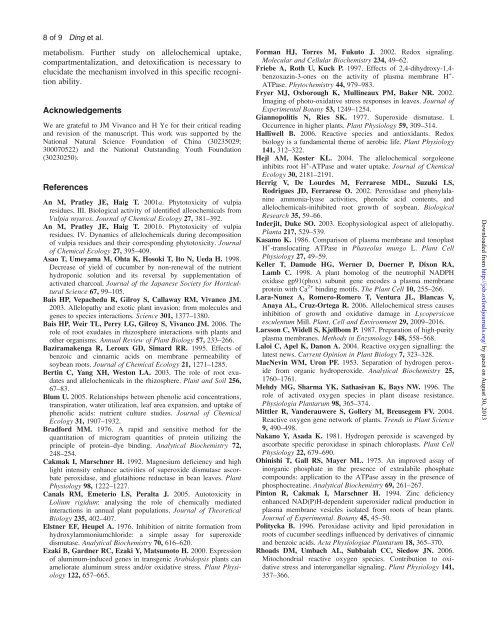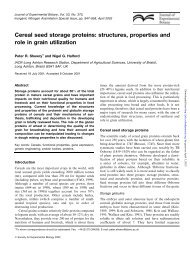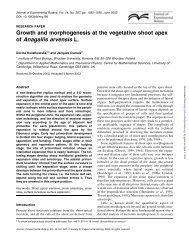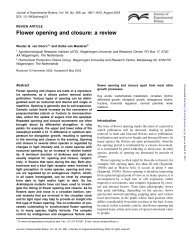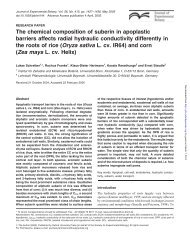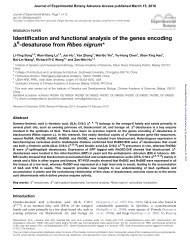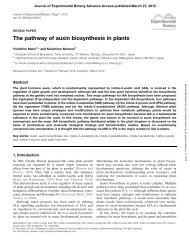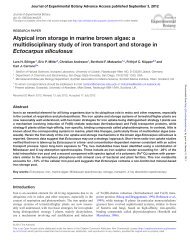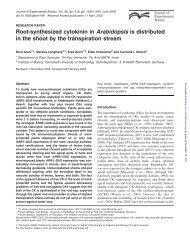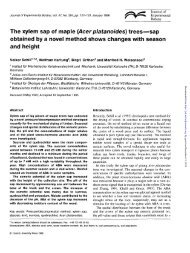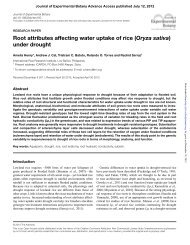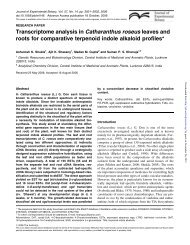Physiological basis of different allelopathic reactions of cucumber ...
Physiological basis of different allelopathic reactions of cucumber ...
Physiological basis of different allelopathic reactions of cucumber ...
Create successful ePaper yourself
Turn your PDF publications into a flip-book with our unique Google optimized e-Paper software.
8<strong>of</strong>9<br />
Ding et al.<br />
metabolism. Further study on allelochemical uptake,<br />
compartmentalization, and detoxification is necessary to<br />
elucidate the mechanism involved in this specific recognition<br />
ability.<br />
Acknowledgements<br />
We are grateful to JM Vivanco and H Ye for their critical reading<br />
and revision <strong>of</strong> the manuscript. This work was supported by the<br />
National Natural Science Foundation <strong>of</strong> China (30235029;<br />
300070522) and the National Outstanding Youth Foundation<br />
(30230250).<br />
References<br />
An M, Pratley JE, Haig T. 2001a. Phytotoxicity <strong>of</strong> vulpia<br />
residues. III. Biological activity <strong>of</strong> identified alleochemicals from<br />
Vulpia myuros. Journal <strong>of</strong> Chemical Ecology 27, 381–392.<br />
An M, Pratley JE, Haig T. 2001b. Phytotoxicity <strong>of</strong> vulpia<br />
residues. IV. Dynamics <strong>of</strong> allelochemicals during decomposition<br />
<strong>of</strong> vulpia residues and their corresponding phytotoxicity. Journal<br />
<strong>of</strong> Chemical Ecology 27, 395–409.<br />
Asao T, Umeyama M, Ohta K, Hosoki T, Ito N, Ueda H. 1998.<br />
Decrease <strong>of</strong> yield <strong>of</strong> <strong>cucumber</strong> by non-renewal <strong>of</strong> the nutrient<br />
hydroponic solution and its reversal by supplementation <strong>of</strong><br />
activated charcoal. Journal <strong>of</strong> the Japanese Society for Horticultural<br />
Science 67, 99–105.<br />
Bais HP, Vepachedu R, Gilroy S, Callaway RM, Vivanco JM.<br />
2003. Allelopathy and exotic plant invasion: from molecules and<br />
genes to species interactions. Science 301, 1377–1380.<br />
Bais HP, Weir TL, Perry LG, Gilroy S, Vivanco JM. 2006. The<br />
role <strong>of</strong> root exudates in rhizosphere interactions with plants and<br />
other organisms. Annual Review <strong>of</strong> Plant Biology 57, 233–266.<br />
Baziramakenga R, Leroux GD, Simard RR. 1995. Effects <strong>of</strong><br />
benzoic and cinnamic acids on membrane permeability <strong>of</strong><br />
soybean roots. Journal <strong>of</strong> Chemical Ecology 21, 1271–1285.<br />
Bertin C, Yang XH, Weston LA. 2003. The role <strong>of</strong> root exudates<br />
and allelochemicals in the rhizosphere. Plant and Soil 256,<br />
67–83.<br />
Blum U. 2005. Relationships between phenolic acid concentrations,<br />
transpiration, water utilization, leaf area expansion, and uptake <strong>of</strong><br />
phenolic acids: nutrient culture studies. Journal <strong>of</strong> Chemical<br />
Ecology 31, 1907–1932.<br />
Bradford MM. 1976. A rapid and sensitive method for the<br />
quantitation <strong>of</strong> microgram quantities <strong>of</strong> protein utilizing the<br />
principle <strong>of</strong> protein–dye binding. Analytical Biochemistry 72,<br />
248–254.<br />
Cakmak I, Marschner H. 1992. Magnesium deficiency and high<br />
light intensity enhance activities <strong>of</strong> superoxide dismutase ascorbate<br />
peroxidase, and glutathione reductase in bean leaves. Plant<br />
Physiology 98, 1222–1227.<br />
Canals RM, Emeterio LS, Peralta J. 2005. Autotoxicity in<br />
Lolium rigidum: analysing the role <strong>of</strong> chemically mediated<br />
interactions in annual plant populations. Journal <strong>of</strong> Theoretical<br />
Biology 235, 402–407.<br />
Elstner EF, Heupel A. 1976. Inhibition <strong>of</strong> nitrite formation from<br />
hydroxylammoniumchloride: a simple assay for superoxide<br />
dismutase. Analytical Biochemistry 70, 616–620.<br />
Ezaki B, Gardner RC, Ezaki Y, Matsumoto H. 2000. Expression<br />
<strong>of</strong> aluminum-induced genes in transgenic Arabidopsis plants can<br />
ameliorate aluminum stress and/or oxidative stress. Plant Physiology<br />
122, 657–665.<br />
Forman HJ, Torres M, Fukuto J. 2002. Redox signaling.<br />
Molecular and Cellular Biochemistry 234, 49–62.<br />
Friebe A, Roth U, Kuck P. 1997. Effects <strong>of</strong> 2,4-dihydroxy-1,4-<br />
benzoxazin-3-ones on the activity <strong>of</strong> plasma membrane H + -<br />
ATPase. Phytochemistry 44, 979–983.<br />
Fryer MJ, Oxborough K, Mullineaux PM, Baker NR. 2002.<br />
Imaging <strong>of</strong> photo-oxidative stress responses in leaves. Journal <strong>of</strong><br />
Experimental Botany 53, 1249–1254.<br />
Giannopolitis N, Ries SK. 1977. Superoxide dismutase. I.<br />
Occurrence in higher plants. Plant Physiology 59, 309–314.<br />
Halliwell B. 2006. Reactive species and antioxidants. Redox<br />
biology is a fundamental theme <strong>of</strong> aerobic life. Plant Physiology<br />
141, 312–322.<br />
Hejl AM, Koster KL. 2004. The allelochemical sorgoleone<br />
inhibits root H + -ATPase and water uptake. Journal <strong>of</strong> Chemical<br />
Ecology 30, 2181–2191.<br />
Herrig V, De Lourdes M, Ferrarese MDL, Suzuki LS,<br />
Rodrigues JD, Ferrarese O. 2002. Peroxidase and phenylalanine<br />
ammonia-lyase activities, phenolic acid contents, and<br />
allelochemicals-inihibited root growth <strong>of</strong> soybean. Biological<br />
Research 35, 59–66.<br />
Inderjit, Duke SO. 2003. Ecophysiological aspect <strong>of</strong> allelopathy.<br />
Planta 217, 529–539.<br />
Kasamo K. 1986. Comparison <strong>of</strong> plasma membrane and tonoplast<br />
H + -translocating ATPase in Phaseolus mungo L. Plant Cell<br />
Physiology 27, 49–59.<br />
Keller T, Damude HG, Werner D, Doerner P, Dixon RA,<br />
Lamb C. 1998. A plant homolog <strong>of</strong> the neutrophil NADPH<br />
oxidase gp91(phox) subunit gene encodes a plasma membrane<br />
protein with Ca 2+ binding motifs. The Plant Cell 10, 255–266.<br />
Lara-Nunez A, Romero-Romero T, Ventura JL, Blancas V,<br />
Anaya AL, Cruz-Ortega R. 2006. Allelochemical stress causes<br />
inhibition <strong>of</strong> growth and oxidative damage in Lycopersicon<br />
esculentum Mill. Plant, Cell and Environment 29, 2009–2016.<br />
Larsson C, Widell S, Kjellbom P. 1987. Preparation <strong>of</strong> high-purity<br />
plasma membranes. Methods in Enzymology 148, 558–568.<br />
Laloi C, Apel K, Danon A. 2004. Reactive oxygen signalling: the<br />
latest news. Current Opinion in Plant Biology 7, 323–328.<br />
MacNevin WM, Uron PF. 1953. Separation <strong>of</strong> hydrogen peroxide<br />
from organic hydroperoxide. Analytical Biochemistry 25,<br />
1760–1761.<br />
Mehdy MG, Sharma YK, Sathasivan K, Bays NW. 1996. The<br />
role <strong>of</strong> activated oxygen species in plant disease resistance.<br />
Physiologia Plantarum 98, 365–374.<br />
Mittler R, Vanderauwere S, Gollery M, Breusegem FV. 2004.<br />
Reactive oxygen gene network <strong>of</strong> plants. Trends in Plant Science<br />
9, 490–498.<br />
Nakano Y, Asada K. 1981. Hydrogen peroxide is scavenged by<br />
ascorbate specific peroxidase in spinach chloroplasts. Plant Cell<br />
Physiology 22, 679–690.<br />
Ohinishi T, Gall RS, Mayer ML. 1975. An improved assay <strong>of</strong><br />
inorganic phosphate in the presence <strong>of</strong> extralabile phosphate<br />
compounds: application to the ATPase assay in the presence <strong>of</strong><br />
phosphocreatine. Analytical Biochemistry 69, 261–267.<br />
Pinton R, Cakmak I, Marschner H. 1994. Zinc deficiency<br />
enhanced NAD(P)H-dependent superoxider radical production in<br />
plasma membrane vesicles isolated from roots <strong>of</strong> bean plants.<br />
Journal <strong>of</strong> Experimental. Botany 45, 45–50.<br />
Politycka B. 1996. Peroxidase activity and lipid peroxidation in<br />
roots <strong>of</strong> <strong>cucumber</strong> seedlings influenced by derivatives <strong>of</strong> cinnamic<br />
and benzoic acids. Acta Physiologiae Plantarum 18, 365–370.<br />
Rhoads DM, Umbach AL, Subbaiah CC, Siedow JN. 2006.<br />
Mitochondrial reactive oxygen species. Contribution to oxidative<br />
stress and interorganellar signaling. Plant Physiology 141,<br />
357–366.<br />
Downloaded from http://jxb.oxfordjournals.org/ by guest on August 30, 2013


